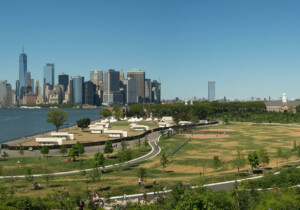It makes sense that one of New York City’s exceptional botanical gardens would develop what would become one of the city’s first green buildings. What is extraordinary is that the Queens Botanical Garden (QBG) began its new Visitor and Administration Building in 2000 – the year LEED certification was launched – and achieved LEED Platinum for a building that ambitiously demonstrates what designed harmony between buildings and nature can be.
Patrice Kleinberg, garden educator for the QBG, and Joan Krevlin, FAIA, LEED AP BD+C, partner at BKSK Architects, led today’s tour, providing perspectives on both the garden’s unique public engagement challenges and the design solutions.
At the earliest stages of the project, the QBG engaged the community to find out what would serve them; across all sectors, they heard “water.” What subsequently evolved was a series of water systems that were both experiential and functional – the building houses not only administrative operations and diverse public programming, but also collects, conserves, cleans, and recycles water.
Three different sustainable roofs serve different purposes. The main structure hosts a solar-powered roof, which generates enough power for about 20% of the building’s operations. The roof of the auditorium is planted with local species, cooling the building. The forecourt’s soaring roof canopy, which provides a shady transition space between the gardens and the interior, doubles as a rainwater collection unit.
The water collected by the canopy is stored in a subterranean 26,000-gallon cistern that is pumped up into the Fountain of Life, which leads to a leafy stream and eventually into a moving body of water that is terraced between the buildings and culminates in a moat-like pond.
The Visitor and Administration Building also sustains a grey water system, wherein water from sinks, toilets, dishwashers, and showers moves through a sandy, planted biotope, from which it can be repurposed.
These innovations have inspired and expanded the QBG’s educational offerings, engendering green cleaning job training, and leading to the development of new K-12 curricula. Importantly, the project’s bioswales have greatly decreased storm run-off in the area’s sewage systems.
Tomorrow, we’ll head over to the World Trade Center Transportation Hub.










